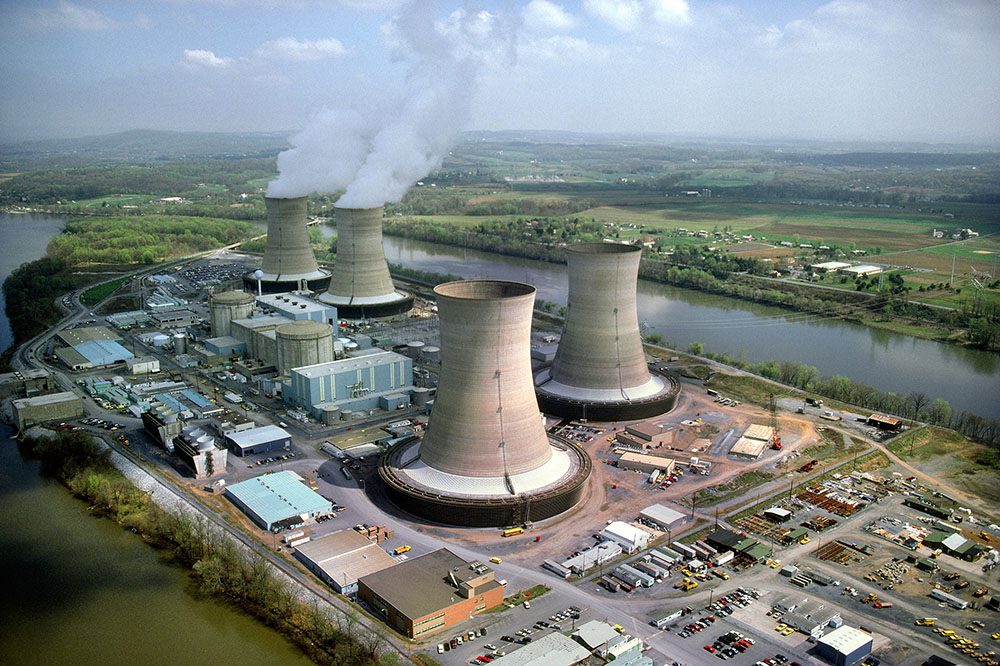Nuclear energy is making a big comeback. In recent months, it’s been getting renewed attention from U.S. government agencies and policy makers for its environmental appeal. President Joe Biden’s Department of Energy recently launched a six billion dollar effort to rescue a number of civil nuclear power plants slated for mothballs. Responding to this, California Governor Gavin Newsom has announced he is seeking some of that funding to keep Diablo Canyon, California’s single remaining nuclear plant, running decades beyond its previously-announced closure, originally slated for 2024–2025.
And in a June 15 op-ed, California’s senior U.S. Senator, Dianne Feinstein added her voice to the growing chorus of calls to keep Diablo Canyon running. Meanwhile, on June 7, the President announced that he’d ask Congress for an additional $4.3 billion to develop domestic-produced low-enriched uranium, the fuel type that powers most current civil reactors. All of this is happening in an international setting characterized by numerous countries warming up to expanded nuclear energy, including Japan, site of the Fukishima-Daiichi accident of 2011. And the pro-nuclear calls have grown steadily in the last few months, quickened by the geopolitical context of bans on Russian oil and natural gas. One key counter example is famously anti-nuclear Germany, which is scrambling to replace the politically unacceptable Russian natural gas it can no longer import by bringing shuttered coal-burning plants back online.
This embrace of new nuclear plants is often backed by a simple environmental and social justice argument: Nuclear currently supplies 20 percent of America’s total electricity but it’s still 52 percent of its emissions-free electricity. Our hunger for power is only growing, and vast regions of the planet lack power or suffer frequent brownouts, which limits education and economic well-being. The emerging global argument in support of nuclear energy is that producing more electricity would be more socially just. Thus considering America’s and the world’s energy needs, this century, we should not only maintain our nuclear power’s current footprint—we need to expand the number of nuclear plants, cut fossil fuel emissions, and reap the climate benefits.
“Nuclear power will save American lives.”
All of that is true.
But there’s another compelling reason for expanding nuclear power—a public health argument you almost never hear anything about. Because the pollution from combustion of fossil fuels, biofuels (which count as renewables even though they produce greenhouse gasses and, in the case of wood chips, take decades to centuries to be renewed through tree growth) is detrimental to human health, this second argument in favor of expanded nuclear even simpler: Nuclear power will save American lives.
But now comes the hard part—convincing the American public.
While her support for Diablo Canyon is a massively positive development, Senator Feinstein’s recent op-ed is a typical example of how pro-environment politicians often portray nuclear energy as a stopgap way to give renewables like wind, solar, or geothermal energy time to catch up to the point where they could replace coal and natural gas-fired plants. But this idea is not grounded in reality. In a recent Intelligence2 debate, opponents of nuclear power expansion maintained that it could not compete with renewables, which they claimed could be scaled up to replace fossil fuels. But doing so would necessitate battery technology or other energy storage capabilities that exist only on very optimistic drawing boards. Last August the U.S. Energy Information Administration issued a report on how battery storage for the electrical grid has been increasing substantially and is expected to continue increasing—but not enough for current intermittent energy sources (solar/wind) to become baseload power in the near future. This does not even touch on the potential toxic waste disposal issues resulting from massive expansion of battery use. In short, we can’t bet the farm on an application in desperate search of its technology. Too many lives are at stake.
Fear versus risk
Despite improvement since the 1990s, air pollution from burning fossil fuels is estimated to still kill more than 60,000 Americans every year by causing cardiovascular and respiratory disease. It also is associated with adverse pregnancy outcomes and is implicated in contributing to development and/or mortality of lung cancer, breast cancer, and thyroid cancer, according to a recent study from Johns Hopkins.
Germany looms as a lesson on how fear of nuclear power is far more deadly than nuclear power itself. Under the guise of transitioning to renewables but coming directly in response to the outcry in the wake of Fukushima, Germany has been shuttering its nuclear plants. The country closed eight reactors from 2011–2021 and three more late last year, leaving only three remaining, which are also scheduled to close by year’s end.
But retreating from nuclear as we ramp up renewable capacity will paradoxically lead to increased burning of natural gas and coal. Last year, coal became Germany’s primary source of electricity, even accounting for the fact that France, whose electrical grid is 70 percent nuclear, has been quietly selling some of that nuclear-generated electricity over-the-border to its anti-nuclear neighbor. Besides that, the dirty little secret of “renewables” is that they consist partly of biofuels (whose carbon emissions are only partly offset by plant growth which is used to generate more biofuels). Most renewables, like solar and wind, generate energy intermittently, which means to be reliable they have to be coupled to baseload energy that can be throttled up 24/7 as needed. So if you are weaning off nuclear, you are likely going to use more coal-fired sources.
A decade ago, researchers at NASA’s Goddard Institute for Space Studies and Columbia University’s Earth Institute determined that nuclear energy had prevented 1.84 million deaths that would otherwise have occurred from air pollution from the years 1971–2009. The researchers also calculated that continuation of nuclear energy could prevent an additional 7.04 million deaths by mid-century. More recent calculations suggest a death toll of 1,100 people per year from air pollution, specifically resulting from Germany’s shutdown of the initial eight power plants beginning in 2011, the year of the accident at Japan’s Fukushima-Daiichi facility.
The United States had its own public reckoning with nuclear power decades earlier, in 1979, after the Three Mile Island power plant accident in Pennsylvania. Stoking popular dread of nuclear energy, The China Syndrome, a star-studded feature film with Jack Lemmon, Jane Fonda, and Michael Douglas, opened just twelve days before the real-life events unfolded in Pennsylvania with a plot centered on exactly that—a reactor meltdown.
In the end, Three Mile Island posed no threat to the plant workers (in spite of a massive voluntary evacuation) and leakage of radioactive material was actually miniscule. The Commission actually said “We goofed”, but the damage was done. The accident and the movie together had launched the anti-nuclear movement on such a trajectory that some 67 planned American nuclear power plants would be canceled by 1988. The 1989 debut of The Simpsons, whose opening sequence portrays the nuclear industry as recklessly unsafe and managed by bumbling fools, seemingly convinced us all that weaning off nuclear was the right decision.

Far from it. In fact, new designs in the last 40 years make the feared meltdown virtually impossible. One method, for example, lets components slow and stop nuclear reactions if power is lost or disrupted, rather than relying on backup power to shut down. Another design uses fuels that operate normally in the liquid state but if they overheat, they drain out. Innovators are also building small modular reactors that can be installed and replaced with all components contained, including the nuclear fuel.
As for the oft-cited concern about nuclear waste disposal, all the waste that we’ve generated since the dawn of nuclear power (83,000 metric tons) could fit on one football field in a pile a few stories tall. Yes, it’s radioactive, but it’s contained in steel canisters embedded in thick cement, and radioactivity lasting for billions of years actually doesn’t make it any more dangerous than chemical waste from solar and wind production, whose disposal is much more voluminous than all the nuclear waste combined, and whose chemical toxicity lasts forever.
“Per megawatt hour, nuclear power plants and their waste are simply more exquisitely concentrated than solar and wind.”
Wind power currently depends on a massive global industry that includes mining of ore and processing in gigantic steel turbines, which typically involves mined coal as a heat and carbon source. Full of electronics utilizing rare Earth elements and heavy metals, photovoltaics are also full of toxic chemicals, just like any electronic device that you use in your normal life. Requiring orders of magnitude more volume of material than nuclear to produce the same amount of electricity, wind farms and solar arrays have limited life spans, just like any other power plant. Elements like the blades from wind turbines or solar panels must be disposed of at the end of their lifetimes, so all of that goes into landfills. More voluminous still than the waste from solar and wind is waste from the combustion of fossil fuels powering the turbines, which does not get buried in cement-encased canisters, nor in landfills, but goes right into the air and into the lungs of people.
Per megawatt hour, nuclear power plants and their waste are simply more exquisitely concentrated than solar and wind.
Once the gravity of climate change really began to sink in starting in the 1990s, America could have embraced nuclear power for its unmatched ability to generate massive amounts of clean energy. That was already clear in the 1960s, when President John F. Kennedy first laid out his vision for expansive nuclear energy, and it is even more certain today. Irrational fear is all that stands in the way.
Radiophobia persists and may keep us debating nuclear power for years. The rest of the world, meanwhile, is forging ahead. China is building 150 new reactors over the next decade and a half, adding to dozens of already operating reactors and dozens more completed reactors awaiting approval to start operating. The list of nations warming up to nuclear, whether to meet emissions goals or for energy independence, is too extensive to list, but it’s worth mentioning Japan, where a majority now support restarting nuclear reactors that have been dormant since the Fukushima accident of 2011.
It’s time for the United States to get on board and lead the way. Instead of the “No nukes!” protest call of the late 1970s, it’s time to make the rallying cry “New nukes!”









